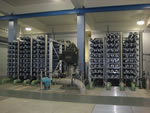Peele Dixie Water Treatment Plant, FORT LAUDERDALE, FL

VALUE DELIVERED
New, more modern water treatment facilities; regulatory compliance; expert installation of a unique membrane technology; professional handling of delicate membrane elements; reliable emergency backup power; single-source convenience; more appealing looking drinking water for customers; softer water to reduce soap scum and scaling and to increase efficiency of water-using appliances; final testing to improve water quality and system performance to ensure optimum operation.
CLIENT OBJECTIVES
To update its water treatment technology, meet regulatory requirements, and improve water quality and appearance.
SCOPE OF SERVICES
Prior to this project's implementation, the client used a conventional lime softening process with granular media filtration to treat its water. Until recently, this was the traditional way to purify the South Florida Biscayne Aquifer raw water supply. To comply with recent amendments to the United States Environmental Protection Agency's Safe Drinking Water Act and its more stringent water quality standards, and to improve the quality of the city's drinking water, the client embarked upon a major upgrade to its treatment process.
To achieve its objectives, the city elected to leverage state-of-the-art reverse osmosis (RO) and nanofiltration (NF) membrane treatment technologies. The city's implementation of these technologies uses a unique “double hybrid RO/NF” membrane design, incorporating both RO and NF membrane elements. This enables the client to achieve its stringent water quality goals with a very low feed pressure of approximately 100 pounds per square inch.
Seeking assistance from a firm with extensive water treatment expertise, the client asked Poole & Kent to schedule, coordinate, procure, construct, and install all facilities and process equipment. The company was also responsible for receiving and coordinating the loading of the membrane elements, which the client purchased directly from the manufacturer.
The scope of work included:
- Four 5-million-gallons-per-day (mgd) capacity five-micron cartridge filters for removal of particulate contaminants from the raw water upstream of the membrane process
- A 12-mgd capacity NF process, consisting of four 3-mgd membrane skids operating at a recovery rate of 85 percent. Each skid includes a dedicated 300-horsepower (hp) vertical turbine membrane feed pump equipped with a variable frequency drive (VFD)
- Antiscalant and sulfuric acid storage-and feed systems for chemical pretreatment of the membrane feedwater to prevent mineral scaling and fouling of the membranes
- Two permeate degasifiers for removal of hydrogen sulfide gas from the membrane permeate
- Caustic soda and hypochlorite chemical storage-and-feed systems for pH adjustment and post-treatment disinfection of the membrane permeate
- A finished water clearwell and transfer pumping system for post-treatment and pumping to finished water storage
- Two 4-million gallon pre-stressed concrete finished water storage tanks
- A high-service pump station for distributing finished water to customers. The station consists of five 250-hp vertical turbine pumps with variable frequency drives
- A concentrate pump station to pump the reject membrane concentrate to the concentrate disposal deep injection well, which was constructed under a separate contract
- Two 1,750-kilovolt-ampere diesel-enginepowered emergency backup generators to power plant equipment in the event ofan outage.
Poole & Kent also coordinated a 30-day process performance test, which was monitored using strict water quality and process performance criteria. Performance testing began in April 2008. The start-up and commissioning phase concluded in July 2008, with all performance testing requirements met. The result was substantially fewer disinfection by-products, more appealing water color and quality, and reduced finished water hardness.
SOLUTIONS
The Construction Management Association of America (CMAA) awarded the project team a Project Achievement Award. It also recognized this project as the top project in its Program Phase, Infrastructure category. In addition, Southeast Construction magazine named the project “Best Civil Project” in its “Best of 2008” project competition.
BACKGROUND
The City of Fort Lauderdale's Walter E. Peele Dixie Water Treatment Plant provides drinking water to the southern portion of the city's service area. This plant, originally constructed in 1926, is an American Water Landmark.




